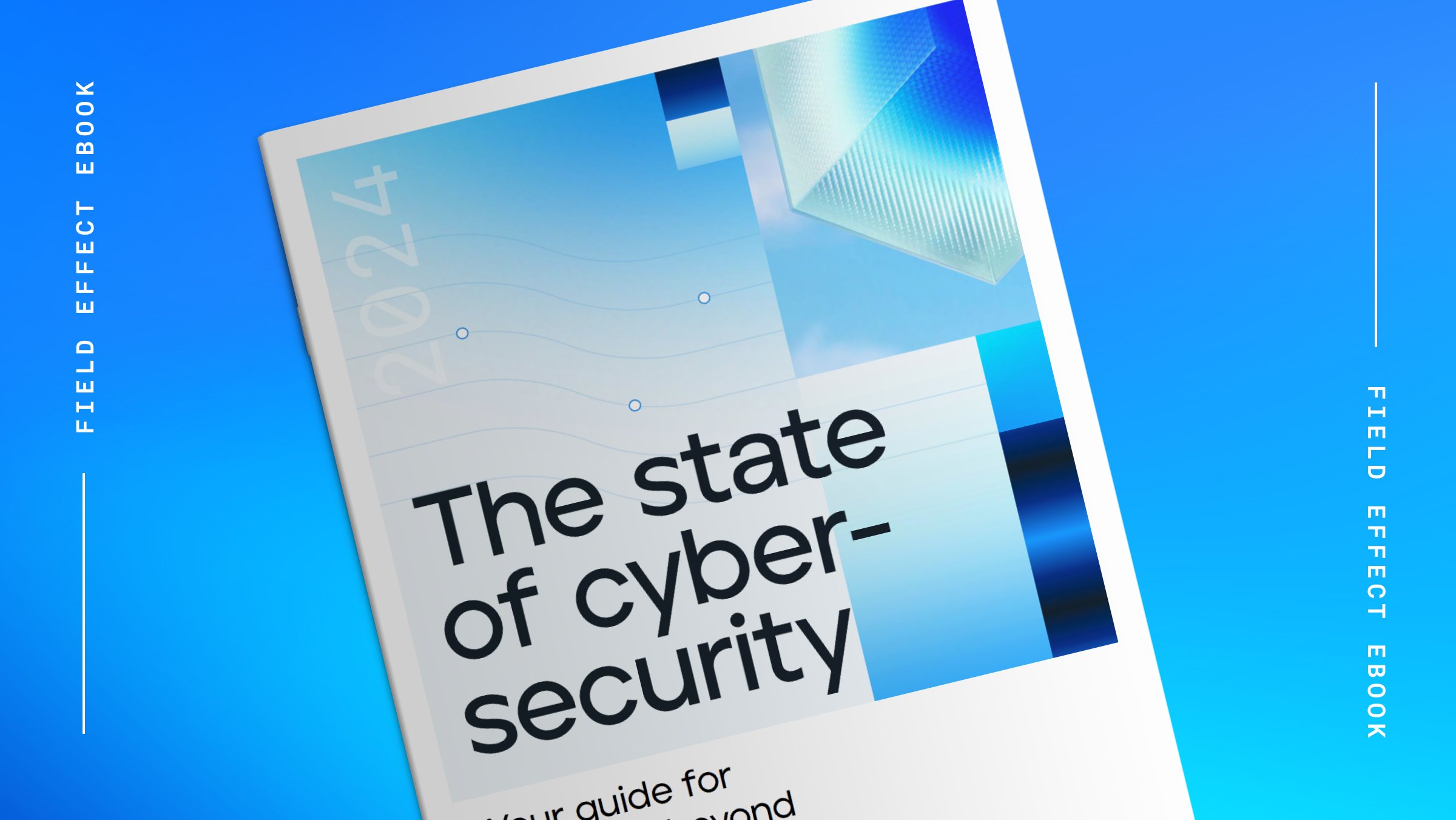
Blog Post
May 28, 2024 | Cybersecurity education
By Field Effect
Last updated: March 4, 2025
Companies worldwide will incur an estimated annual cost of $10.5 trillion due to cybercrime by 2025, marking a substantial rise from the $3 trillion recorded in 2015. Financial services firms may be stuck facing a significant percentage of these damages, as the Boston Consulting Group found that cybercriminals are 300 times as likely to target financial services firms than any other industry.
The reason is straightforward: financial services companies, including accounting, investment, insurance, and consulting firms handle highly sensitive data like financial credentials and personally identifiable information daily. This data has tremendous value to attackers, who could redirect payments, sell private data on the dark web, or hold critical files for ransom to extort large sums.
Many people assume only large banks and institutions are at risk, but the reality is cyber threats put companies of all sizes in the crosshairs. Smaller firms often have fewer dedicated cybersecurity resources and staff but just as much to lose from an attack.
So, understanding the most common threats and assessing your threat surface is the first key step to building a strong defense. Here are some of the top cyber threats to financial services firms, the consequences of an attack, and how to reduce your risk.
Financial services firms are a key target for many cyber threats from various actors with different objectives. Here are some of the top threats.
Social engineering attacks are manipulative tactics cybercriminals use to trick individuals into revealing sensitive information, such as login credentials, financial details, or more. By exploiting human psychology and curiosity, attackers persuade their targets to break standard security practices.
It can lead to unauthorized system access, data breaches, and other severe consequences. Two common methods of social engineering attacks include phishing and business email compromise.
Phishing is an attack in which cybercriminals use email, or sometimes text messages or phone calls, to trick unsuspecting individuals into revealing sensitive information, such as passwords, credit card numbers, or personal data, or otherwise furthering the attack. Phishing typically tries to make victims believe they are interacting with a trustworthy source.
Phishing attacks are widespread and rely on psychological manipulation and the exploitation of human vulnerabilities to achieve their objectives. A single link or file click can launch malware or lead to a compromised account. Stealing just one employee's credentials gives attackers a stepping stone into company systems.
BEC refers to a social engineering attack in which attackers gain unauthorized access to business email accounts to deceive or defraud organizations. Typically, the perpetrators impersonate trusted individuals, such as executives or vendors, and manipulate employees into taking fraudulent actions, such as initiating unauthorized wire transfers or disclosing sensitive information.
BEC attacks can lead to significant financial losses and compromised data. The FBI reports BEC scams alone have cost global victims more than $50 billion since 2013. From December 2021 to December 2022, there was a 17% surge in identified global losses related to BEC.
Both phishing and BEC exploit human nature and relationships of trust. Comprehensive employee training is key to helping staff identify subtle indicative signs of social engineering attacks before falling victim. Enabling multi-factor authentication provides an additional critical layer of protection even if login credentials are compromised.
Malware refers to all types of malicious software, like viruses that infect systems and networks to steal data or money. Ransomware is a specific type of malware that encrypts files on devices and servers until the victim pays the ransom demand.
In 2021, the financial sector represented 22% of ransomware attacks. Financial firms house massive troves of sensitive client data and files, making them prime targets and ideal victims for ransomware schemes. A successful attack can lock staff out of critical systems and data, crippling operations. Quick detection and rapid response are crucial to preventing widespread encryption across shared drives and limiting overall damage.
However, malware threats extend beyond just ransomware. Banking trojans are tailored strains of malware that steal online banking credentials and payment card data from infected computers. Spyware gathers confidential data and tracks activities, snooping for anything of value like account numbers, passwords, or personal data. Robust and layered anti-malware defenses are a requirement to defend against these evolving cyber threats.
Financial companies store highly sensitive and regulated data which, if breached, can have massive ripple effects for consumers and the company. In 2022, the average cost of a data breach in the financial industry worldwide was nearly $6 million.
Most security experts agree it's largely a matter of when, not if, a breach will happen. Financial services firms must prepare for both breach prevention and timely incident response.
Insider threats refer to the risks posed by individuals within an organization who misuse their access privileges or exploit their position to compromise the security and integrity of systems, data, or assets. These individuals could be current or former employees, contractors, or business partners.
Insider threats can involve intentional actions, including unauthorized data access, theft, and sabotage, or unintentional actions, such as accidental misdelivery. Financial services firms face significant challenges in mitigating insider threats due to the access employees have to valuable financial data and systems.
Your firm needs stringent access controls and multi-factor authentication over the most sensitive systems and data repositories. Monitoring for abnormal patterns of access can also help catch issues early. Proper security training and awareness are critical for all employees and third parties handling highly confidential data.
DDoS attacks aim to overwhelm systems and make online resources inaccessible to users. Attackers typically flood servers with more junk web traffic than they can handle or exploit vulnerabilities in website codes and functionality.
Even brief downtime during DDoS attacks can have major client and revenue implications for financial services firms. Corero's white paper reveals that the average cost of a DDoS attack in the U.S. is approximately $218,000, excluding any expenses associated with ransomware.
Customers may suddenly be unable to access online banking portals, mobile apps, websites, or customer service resources. Considering the massive reliance on digital channels in finance, DDoS mitigation and protection should be high on your priority list.
As financial services firms continue adopting cloud computing, their threat landscape has expanded beyond the four walls of corporate environments. Misconfigurations in cloud storage or financial applications can accidentally expose sensitive data. Similarly, vulnerabilities or flaws in a cloud vendor's own security could also trickle down to their customers.
Threats like compromised credentials, denial of service attacks, system exploits, and malware also apply to the cloud. Ensure any cloud vendors you leverage can provide adequate security for the sensitive data stored and applications hosted there and that any cybersecurity solutions you rely on can detect and respond to cloud-based threats.
Nation-state cyber threats come from government-funded bodies conducting espionage, often to steal confidential data for political, economic, or military gain. Advanced persistent threats, or APTs, refer to sophisticated threat groups like state-sponsored or criminal syndicates that dedicate tremendous time and resources toward compromising high-value targets. Financial services firms with important clients or government-related information are at heightened risk of state-sponsored cyberattacks.
According to the Financial Services Information Sharing and Analysis Center, global tensions could fuel further attacks by state-backed hackers and patriotic hacktivists. Their stealth, patience, and continuously evolving tactics make them exceptionally challenging to detect and stop earlier.
Dive into the past, present, and future of cybersecurity with The State of Cybersecurity eBook.
A successful cyberattack on a financial services provider often results in direct financial loss from stolen funds or extortion—but indirect follow-on costs like business disruption, regulatory noncompliance fines, and reputational damage frequently exceed the initial monetary impact. The total fallout can range from thousands to millions of dollars depending on the company's size and the breach's scale.
Some of the most concerning potential business impacts include:
Given these risks, no financial services provider can afford to ignore or downplay the danger cyberattacks pose in today's increasingly digital landscape. Sensitive data, mission-critical systems, and customer trust make financial firms prime targets for everything from opportunistic cybercriminals to sophisticated nation-state hackers.
Regulatory requirements around consumer data protection are increasing. Given the highly sensitive nature of the data housed by financial services, following rigorous cybersecurity best practices is a must. Some of the key steps to implement include:
Download our handpicked collection of cybersecurity resources and start strengthening your firm's cyber defence.
Today's complex cyber threat landscape for financial services firms requires specialized solutions. Understanding and mitigating risks from social engineering attacks, data breaches, advanced persistent threats, and more is important, but managing these cybersecurity threats should not take time away from your clients and essential business activities.
At Field Effect, we believe that cybersecurity should be accessible and manageable for all businesses, regardless of their size. Our flagship product, Field Effect MDR, is a user-friendly platform that simplifies cybersecurity. It detects and responds to abnormal behaviors, pinpoints threats and vulnerabilities, and provides crucial security for your organization.
Partner with Field Effect today and take the first step toward a safer, more secure future. Don't just react to cyber threats: anticipate them, be prepared, and stay one step ahead.


